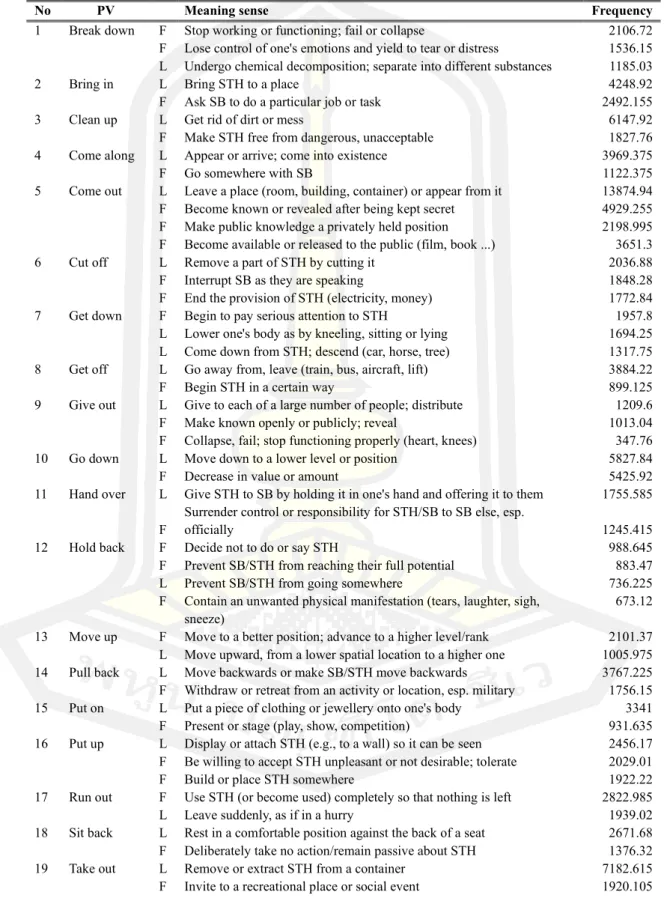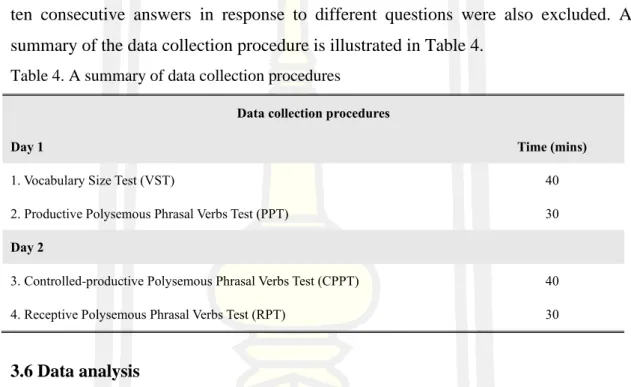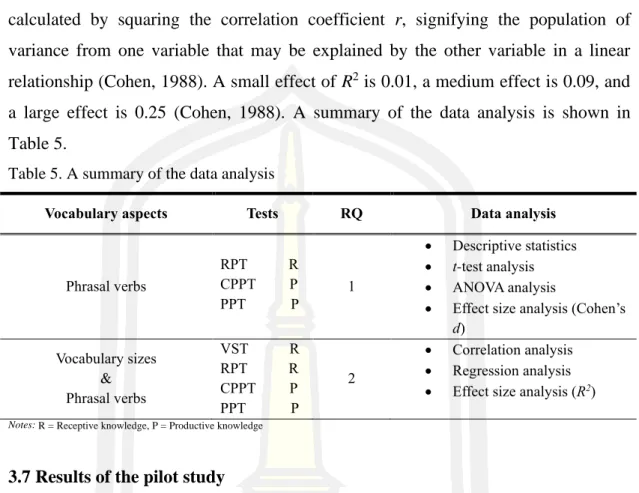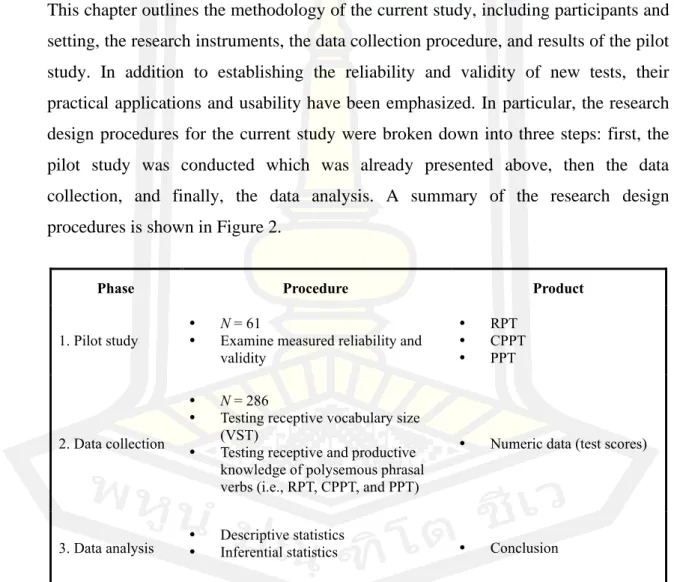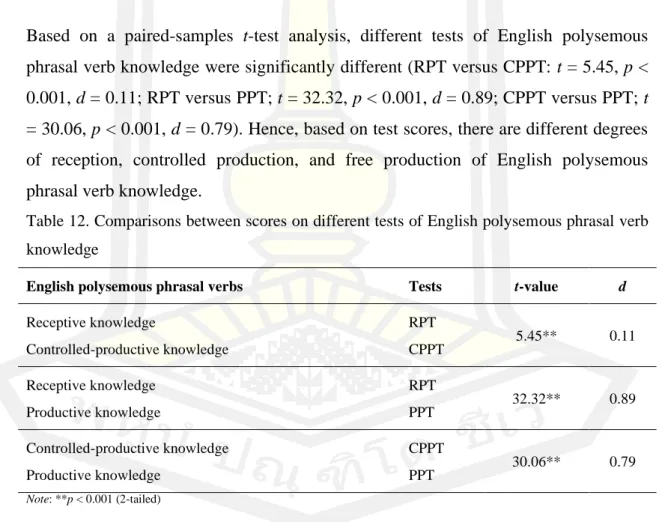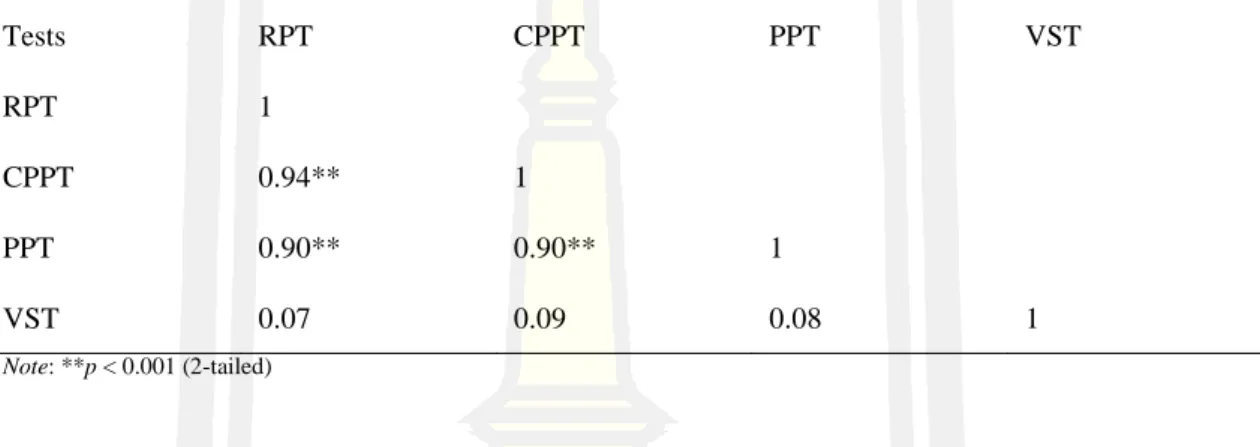TITLE Profiling receptive and productive English polysemic phrasal verbs among Thai EFL High School Learners. Therefore, this study investigated Thai high school students' receptive and productive knowledge of English polysemic phrasal verbs.
INTRODUCTION
- Background to the study
- Purposes of the research
- Scope of the research
- Significance of the study
- Definitions of terms
- Organization of the thesis
Therefore, the current study focused on high school students' receptive and productive knowledge of English polysemous phrasal verbs. This study investigates Thai EFL learners' receptive and productive knowledge of English polysemous phrasal verbs.
LITERATURE REVIEW
Construct of the current study
- Construct of vocabulary knowledge
- Knowing a word
- English phrasal verbs
- Classification of phrasal verbs
- Roles of English phrasal verbs in language learning
Polysemous Verbs: As with other verbs, verbs can be polysemous (have multiple meanings). However, the current study focused on the semantic variants of verbs, taking polysemy into account.
Vocabulary assessment
- Assessing receptive vocabulary knowledge
- Assessing productive vocabulary knowledge
- Assessing knowledge of English phrasal verbs
- Assessing receptive knowledge of English phrasal verbs
- Assessing productive knowledge of English phrasal verbs
Two gaps are included, corresponding to each of the two words that make up the PV (lexical verb and adverbial particle). The first letter of each of the two words is provided to limit the PV options.
Previous related studies on vocabulary acquisition
Extending the study to a larger sample size may shed light on the relationship between receptive and productive knowledge. The results suggest that both receptive and productive knowledge of word knowledge aspects are crucial for the growth of vocabulary knowledge. In addition, the study aimed to determine how much knowledge of receptive and productive affixes increases vocabulary size in the Thai EFL context.
There was a correlation between EFL learners' receptive and productive knowledge of English affixes and the size of their receptive and productive vocabulary. The results support previous claims that affix knowledge is positively associated with receptive and productive vocabulary size (Hayashi & Murphy, 2011; Mochizuki & Aizawa, 2000). Furthermore, the correlation analysis revealed a correlation between receptive and productive knowledge of lexical collocations.
Previous related studies on English phrasal verbs
Unlike Garnier & Schmitt (2016), focusing on productive knowledge, Zhang and Wen (2019) investigated receptive knowledge of polysemous phrasal verbs. The results showed that the participants had good receptive knowledge and adequate productive knowledge of the target polysemetic phrasal verbs. The findings showed that the participants of the English program understood most verbatim phrasal verbs, followed by aspectual phrasal verbs and idiomatic phrasal verbs.
Paugtes (2020) investigated how bilingual and mini-bilingual students use phrasal verbs and the type of phrasal verbs. In contrast, the study by Paugtes (2020) shows that students' proficiency level is not related to their knowledge of phrasal verbs. Boontong (2015) investigated Thai learners' preferences for English phrasal verbs compared to their single verb equivalents.
Summary
35 . more orthographic words treated semantically as a unit; 2) phrasal verbs require more complex processing than single word verbs to understand their meaning, and 3) most phrasal verbs in nature are polysemous and have multiple meanings. On the contrary, the phrasal verbs could not always be replaced with one-word equivalents due to their unnatural sound and meaning differences. Furthermore, the researchers focus on the one meaning of phrasal verbs and do not investigate the correlation between learners' skill level and phrasal verb knowledge.
Consequently, the current study seeks to fill the gap by examining learners' receptive and productive knowledge of polysemous PVs and determining whether learners' vocabulary size is related to learners' receptive and productive knowledge of polysemous PVs. Receptive and productive knowledge of English polysemous phrasal verbs was measured using three tests, two adapted and one newly developed. The Polysemous Phrasal Verb Receptive Test (RPT) was based on the work of Sonbul et al (2020), the Controlled Polysemous Phrasal Verb Test (CPPT) was based on the work of Garnier and Schmitt (2016), and the productive Phrasal Verb Test plural (PPT) was a newly developed test based on Sonbul et al.
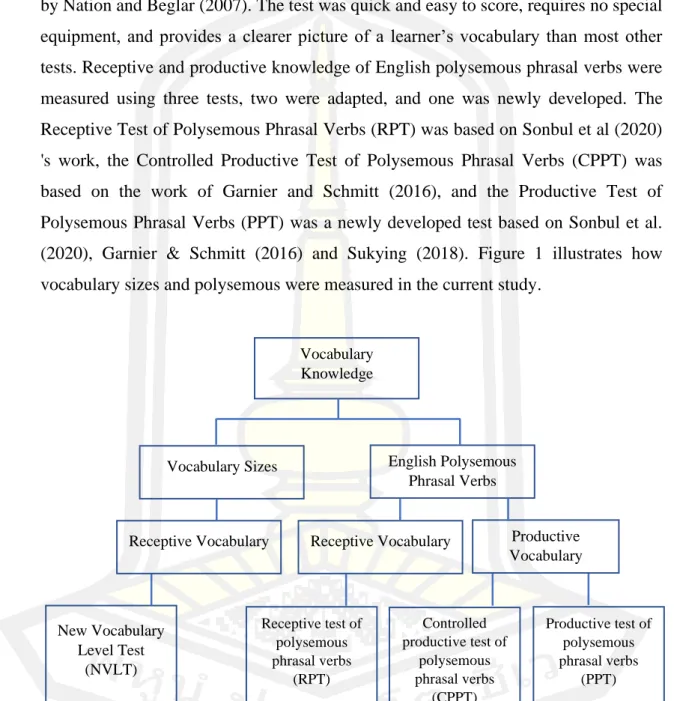
RESEARCH METHODS
- Research paradigm and design
- Participants and setting
- Ethical consideration
- Research instruments
- Vocabulary knowledge test
- Phrasal verb knowledge tests
- Data collection procedure
- Data analysis
- Results of the pilot study
- Summary
The Productive Phrasal Verb Test (PPT) was newly developed based on the LPAK task format of Sukying (2018). A comparison between receptive and productive tests of knowledge of English polysemous phrasal verbs in a pilot study. These innovative measures of English phrasal verbs take advantage of advances in knowledge about English phrasal verbs.
The contributions of English polysemous phrasal verb knowledge to vocabulary size are considered low predictors. Each type of English polysemous phrasal verb knowledge requires different receptive and productive measures (Schmitt, 2010, Nation, 2013). Appendix B: Productive Polysemous Phrasal Verbs Test (PPT) Instructions: Each item contains two parts (Xa and Xb).
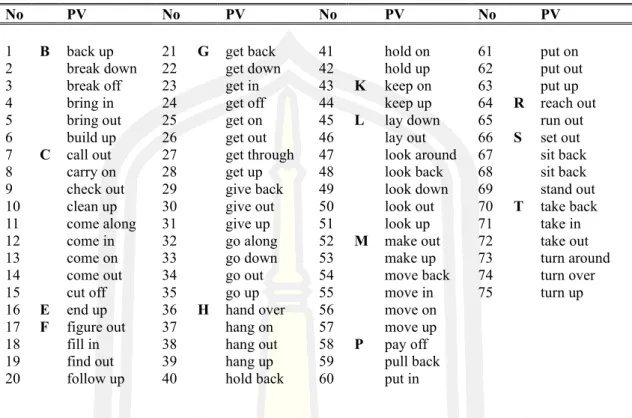
RESULTS
English polysemous phrasal verb knowledge
The Controlled-Productive Polysemous Polysemous Phrasal Verb Test (CPPT) was also used to measure participants' partial productive knowledge of phrasal verbs. This section summarizes the high school students' (N = 286) scores on the receptive and productive English polysemic verb knowledge tests, i.e., RPT, CPPT, and PPT, and their vocabulary size, i.e., VST. Percentages are used to compare performance on polysemic verb tests, which vary across tests.
The normal distribution of performance across different English polysemic verb knowledge tests was further verified by the skewness and kurtosis values shown around ± 1 (all ≤ 0.2); therefore, there was no violation of the statistical assumption. Based on a paired-samples t-test analysis, different tests of knowledge of English polysemic phrases were significantly different (RPT vs. CPPT: t = 5.45, p <. Thus, based on test scores, there are different degrees of reception, controlled production, and free production of knowledge of English polysemic verbs.
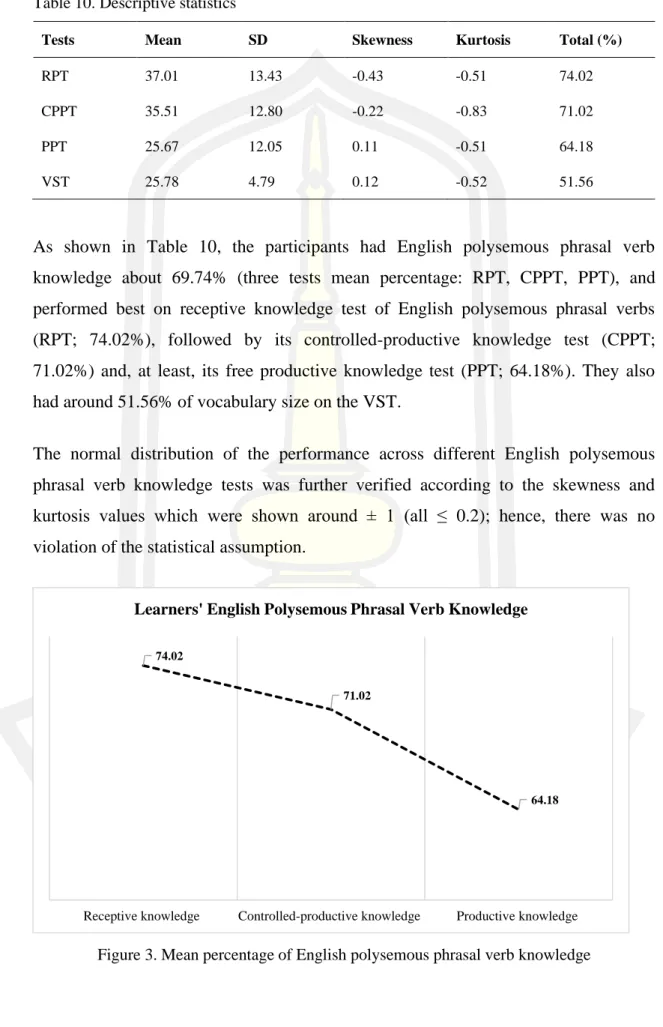
Vocabulary size and English polysemous phrasal verb knowledge
Forced-entry regression analysis was also used to estimate the predictors of English polysemous phrasal verb knowledge to vocabulary size. The explanatory variables, English polysemous phrasal verb knowledge (RPT, CPPT and PPT), thus accounted for 1.1% of the variability in the participants' vocabulary size (VST). This regression model has no global effect size (f2 = 0.01). However, in terms of the regression results, this may be the initial evidence to further investigate and describe the relationship between English polysemous phrasal verb knowledge and vocabulary size knowledge.
Summary
It should be noted that students' vocabulary size may be insufficient to build on English polysemous phrasal verb knowledge. The three measures of polysemous phrasal verbs used in the current study indicate different degrees of phrasal verb knowledge. The results of the present study provide primary information on the acquisition of knowledge of polysemous phrasal verbs.
This implies that the contributions of English polysemic phrasal verb knowledge to vocabulary size are considered very small predictions. In particular, learners' vocabulary size may be insufficient to build on their English polysemic phrasal verb knowledge. Knowledge of English polysemic phrasal verbs is one of the most effective alternatives to improve Thai EFL learners' English language learning.
DISCUSSION AND CONCLUSION
Receptive and productive English polysemous phrasal verb knowledge
This study examined the receptive and productive knowledge of English polysemic verbs among secondary school students in Thailand using the multiple test battery. Performance on these tests reflects the degree of polysemic verbs and their acquisition. In contrast, the CPPT reflects participants' ability to remember and create polysemic verbs when prompted in the given sentences.
This means that productive knowledge of phrasal verbs may not be mastered if receptive knowledge of phrasal verbs is not fully acquired. The results showed that participants had better receptive knowledge than productive knowledge of the target polysemous phrasal verbs. The results show that productive use of phrasal verbs may not occur if a particular phrasal verb is not fully mastered.
Relationship between English polysemous phrasal verb knowledge and
Although the study demonstrates clear detail in the area of verb knowledge, more research is still needed to more clearly describe its nature and conceptualization in acquisition and development and offer its benefits for pedagogy. So there was no correlation between the scores on the English exam and the verb test. Nevertheless, the results of the current study provide important information about the influence of vocabulary size on the acquisition of knowledge of English polysemic verbs.
Although the study indicates clear details in the domain of phrasal verb knowledge, it still needs more research to describe its lively nature and conceptualization in learning and development and offer benefits for pedagogy. Different contexts and methods may further prove any better evidence, indicating more positive contributions of vocabulary size to English polysemic phrasal verb knowledge and any other English aspect that increases English polysemic phrasal verb knowledge. This current evidence can also help to understand the situation of polysemic phrasal verb knowledge among high school students in Thailand and provide a foundation for pedagogical practices and the growth of vocabulary knowledge.
Conclusion
65 The current study can contribute to the literature by illustrating the students' receptive and productive knowledge of polysemous phrasal verbs and the relative contribution of the students' vocabulary size to their knowledge of polysemous phrasal verbs. Overall, this study proposes an empirical evidence for the English polysemous phrasal verb knowledge acquisition of Thai EFL learners by suggesting the natural construction of the English polysemous phrasal verb knowledge in Thailand and the vocabulary facilitations to increase it.
Implications
- Theoretical contribution
- Methodological contribution
- Pedagogical contributions
Second, the Controlled-Productive Polysemous Phrasal Verb Test (CPPT) contained gap-filling questions in which a defining context (Garnier & Schmitt, 2016) assesses the ability to recall and generate polysemous PVs when prompted. Finally, the Productive Polysemous Phrasal Verb Test (PPT), newly developed based on the LPAK task format (Sukying, 2018), assesses participants' capacity to recall and produce polysemous PVs. A pioneering battery of English polysemic phrasal verb knowledge tests was developed to account for receptive, controlled-productive and free-productive knowledge.
The findings demonstrate an empirical principle for teaching and learning knowledge of polysemic verbs in English. In particular, the knowledge, range and depth of English vocabulary can help students build their understanding of English polysemic phrasal verbs and facilitate efficient development of the English language. The instruction should explicitly teach the comprehensive concept of English polysemic verb knowledge and, as an alternative to.
Limitations and recommendations
68 broadening and deepening learners' vocabulary knowledge, it can be a beneficial option. The implications of the current study can help to develop policies in English teaching. An investigation into Thai learners' understanding of English phrasal verbs: The case of Thai high school students in Thai and English programs. Polysemic English phrasal verbs: EFL textbook distribution, students' receptive and productive knowledge and teachers' beliefs in the Greek Cypriot context.
Most commonly used English phrasal verbs in American and British English: A multi-corpus examination. Exploring factors contributing to receptive and productive knowledge of phrasal verbs in the EFL context. Level of Competence in the Use of Common Phrasal Verbs by Students of Assumption University. Thammasat University.
An investigation of the level of competence in MEC students' recognition and use of common three-word phrasal verbs. Appendix C: Controlled-Productive Polysemous Phrasal Verbs Test (CPPT) Directions: Read each sentence carefully, then write what you think the missing word (a phrasal verb) is in the space next to the sentence.

